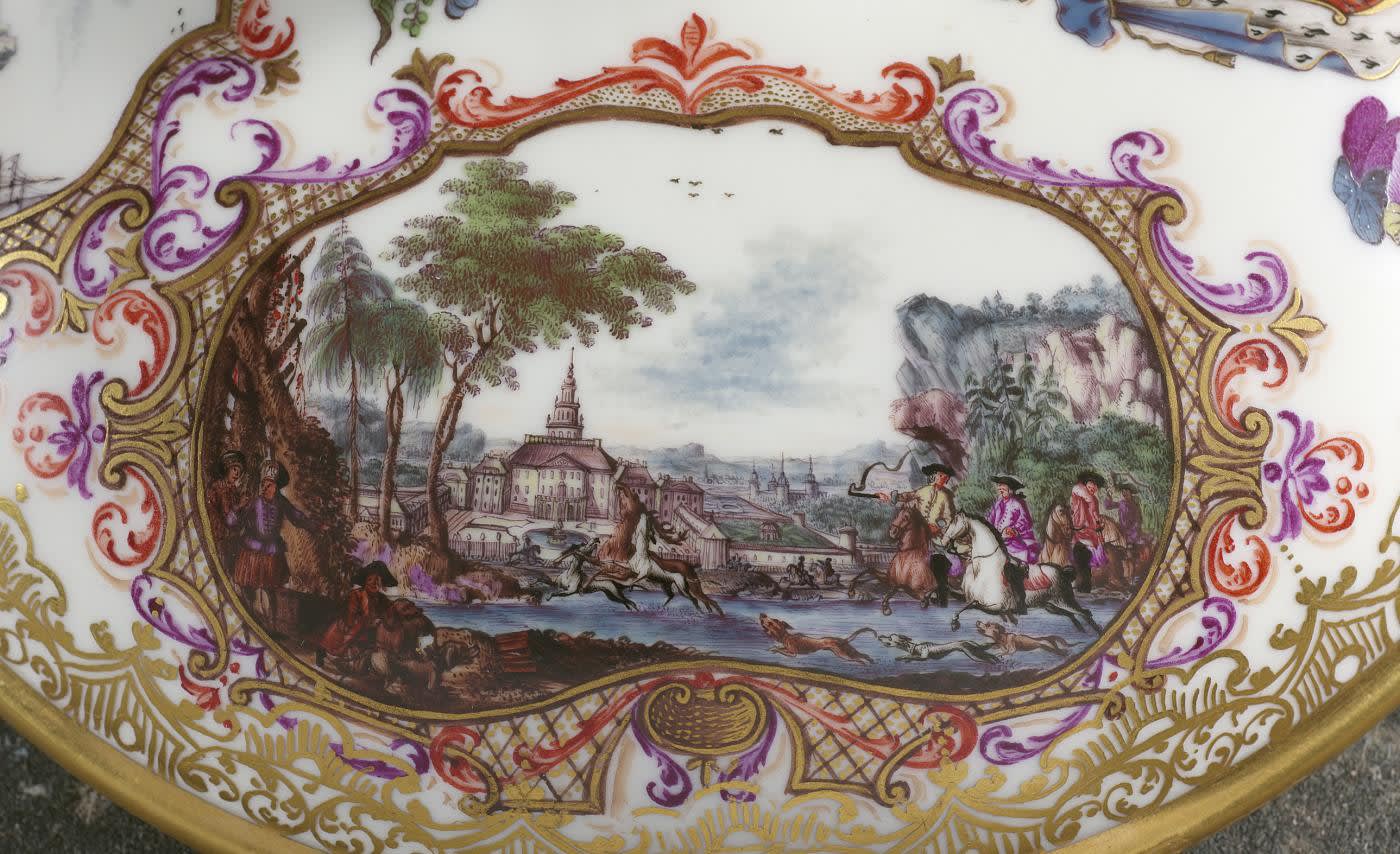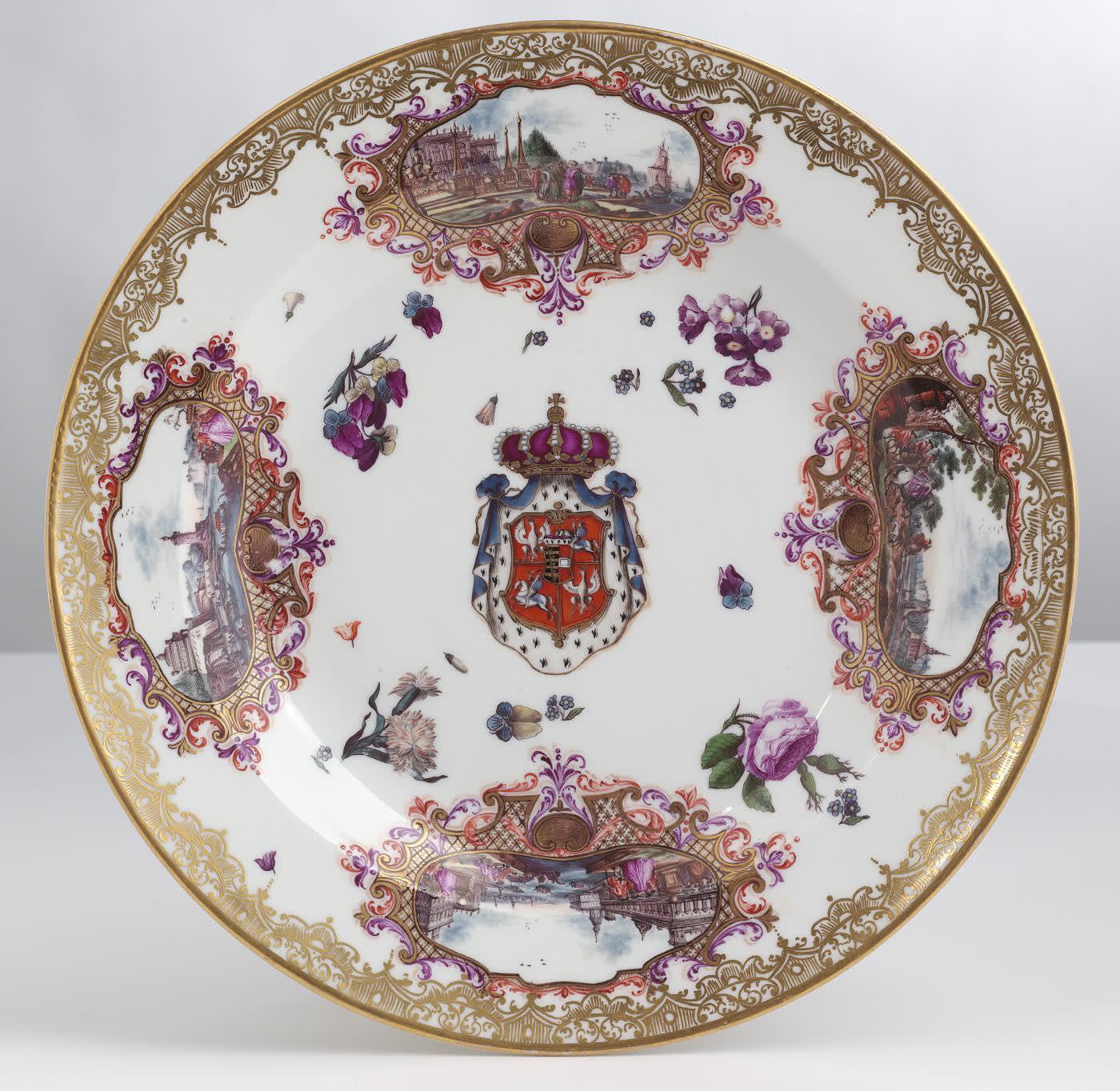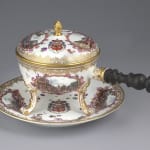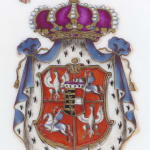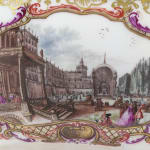The Chafing Dish.
Of circular bowl shape, raised up high on three scrolled and acanthus moulded feet, which are enriched in gold and that are modelled as is also the acanthus moulded handle strut by J.J.Kaendler, the dish beautifully decorated at the front with the Royal and Electoral Armorial, flanked on one side with a spray of purple flowered auriculas and on the other a single iron red dianthus flower head beside a spray of speedwells. Further round towards the handle there are two panels very finely painted after Melchior Kusel, within barbed cloud shaped panels, framed within an intricate gold and black enamel diapered trellised border enriched with iron red and purple feathered scrolls, fleur de lys, panels of gilt shagreen and supported on a single scallop shell.
- The first Panel.
Painted with a Palatial scene, showing the side wing of a huge Royal Palace, built in the Italian manner and surmounted by figural statues, a group of courtiers including two Ladies and Gentlemen are at conversation below a giant portico, whilst another group to the right survey the high formal cypress gardens that are shown beyond the formal parterre in the middle of the scene, in the centre of the view stands a vast arched tunnel which stretches back in the distance to further formal gardens, through which further Courtiers progress.
- The second Panel.
Painted with a scene amongst Cliffs in a mountainous setting showing a mounted group of Aristocrats and Courtiers led by a Man wearing a puce carmine jacket riding on a grey, being attended by two Royal Miners wearing their notable badged hats, another personal attendant looks after two greyhounds to the right of the scene. In the distance a castle sits high above a neighbouring town, before an Arcadian wooded landscape stretching back to the mountains in the distance, birds fly above in the blue clouds.
All beneath a gold scrolled and hatched formal geometric border, which extends in thickly applied gold to the interior of the chafing dish. A very finely turned pear wood handle, created in the silver manner is fitted into the acanthus-moulded strut, the carefully positioned screw holes are framed with gold.
The cover.
The slightly domed cover with solid gold artichoke finial raised upon a bevelled support, the Royal and Electoral arms flanked by two heartsease flowers, a sprig of iron flowering sweet pea and speedwell, there are three panels painted after Melchior Kusel.
- The first view
Painted with a Deer hunt in full flight at the moment of capitulation a white deerhound drags down the running stag as its inclined head bellows towards the sky, a huntsman wearing the yellow coat of the Saxon Royal hunt points towards the captured ‘quarry’ whilst another draws his sword in readiness for the ‘coup de grace’. The hunt takes place upon a plateau above the formal gardens of a palace beneath and is framed by cliffs on both sides and to the left more unmounted members of the hunt lie in readiness to loose their hounds.
- The second view
Painted with a waterside embarkation, showing an Italianate colonnaded Palazzo, surrounded at the waters edge with elegant barges carrying courtiers, a galleon lies to the right of the scene and on the left a group of Aristocrats converse convivially.
iii. The third view
Painted with a similar waterside view, with Palaces on both sides, a galleon in the distance and two groups of Courtiers gathered together, one group with a Lady attended by a dwarf being kissed upon the hand by a gracious Gentleman, the yellow stucco palace on the left classical architrave and vermiculated pilasters
The Stand.
The Royal and Electoral Arms placed centrally in the middle of the dish, it is surrounded by botanically correct individual European flowers, including purple flowered auriculas together with speedwell, an open rose with speedwell, white flowered dianthus tinged with red and a spray of wild pansies or heartsease, encircled by four scrolled panels containing further scenes after Melchior Kusel, with the formal gilt border.
- The first view.
Painted with a scene of courtly life beside the waterfront, on the left is shown a very elegant classical building with a fountain and obelisks within the parterre, a caped man wearing a turban points his arm towards a galleon and further figures converse at the waters edge, in the distance high up on the cliff is a turreted castle.
- The second view.
Showing a hunting party entering from the left beside a classical urn, its support showing husk and paterae ornamentation, the hunting group shows three mounted aristocrats attended by a servant on foot, three dogs wait alertly on the right, in the centre of the scene is a mounted courtier with a large bird of prey possibly a peregrine upon his princely arm, the landscape extends through wooded glades to a small village beneath tall sublime cliffs in the distance.
iii. The third view.
Painted with a Venetian-like scene, looking down a central canal framed on each side with long classical buildings in the finest architectural style, in the foreground are four groups of Courtiers, the most prominent on the left showing a lady in a puce carmine gown talking to a scarlet coated gentleman who hold a Malacca cane, to the right sits an artist pointing to a building beyond and sketching at the same time with his left hand, gondolas ply the blue waters that stretch out into the lagoon.
- The fourth view.
Painted with a fortress scene beside a harbour, the fortified arsenal heavily turreted to the left, barges move back and forth in the middle of the scene on the waters, and to the right a Gentleman points out the lighthouse to two Ladies, they stand before a huge Equestrian statue of a rearing white horse that dominates the right side of the scene.
As the date of the Commission of the Porringer, Cover and Stand is twenty five years after the marriage of Frederick –Augustus II, Elector of Saxony, King Augustus III of Poland and his Queen Maria-Josepha, surely it cannot be a coincidence, for among the very full scenes, which are drawn in inspiration and linked to the work of the engraver Melchior Kusell, are weaved a rich tapestry alluding to the triumph of a very personal bond of love. Kusell’s engravings ‘Verschiedene ansichte in Italien, Carnthen und Friul’, were published by Johann Wilhelm Bauer in Augsburg 1679. Even the Porringer’s shape is one that is found in silver shapes of the period, then as now alluding to the span of commemoration of twenty-five years.
When considering both these points it becomes clear that the commission was an entirely personal one and we know that it was at the Queen’s explicit instruction that J.J.Kaendler became involved in its design and to model the acanthus moulded scrolled feet and the acanthus moulded strut that fits the pear wood handle. Kaendler’s Taxa report for April 1745 states, ‘Zu einem Reintel fur lhro Majest. Die Konigin einen sauber verzierten Fuss poussiret and 1 verzierten Fuss and Stiel zu einen Reintel in Gestalt eines Tiegels gefertiget’, The Queen’s commission is a homage to the Arts, which aptly applies to the meaning of the acanthus plant itself. The Chafing dish and stand should be regarded as a personal gift from a wife to her husband, the fact that it has been executed in the finest porcelain of the period and the rank of the persons involved becomes almost second nature to the true domestic symbolism that lies at the heart of the gift.
The nature of symbolism and the secret signs of love had been a preoccupation for the ruling classes since antiquity but were revived with great interest from the time of the Renaissance. This was augmented further, at the beginning of the eighteenth century, by a fascination with the secret Turkish language of flowers, which was introduced to Europe by Lady Mary Wortley Montague, the wife of the ambassador from the Court of St. James to Constantinople. Flowers had long been the sign of romance but now lovers were able to send messages and proclaim their love either by sending posies of flowers or by appearing in portraits holding certain flowers or by commissioning, as with this Porringer, special objects illustrating their private thoughts.
On the Porringer’s cover beside the personal arms of the Elector and King appear the heartsease or wild pansy, which shows the two faces of togetherness and thoughtfulness, the iron red genista or broom, on the right, means a Union which would refer to the King and Queen (husband and wife). The panel on the cover (Fig.X) showing the Deer hunt is linked to both love and Royal rank for the stag was reserved for Royal hunts only across Europe. The animal also has links with Venus, being symbolic of love and fertility and in this scene the deer is being chased and then caught, which alludes to a chase which culminates in the personal union of two lovers and therefore the ‘Triumph of Love’. The other scenes are filled with vignettes of courtly life each showing the kissing of the hand of a Lady by a Gentleman.
The flowers that appear immediately flanking the Armorial on the Porringer itself are the Auricula and the pink carnation placed together with the Speedwell. The spray of Auriculas symbolises a union of primal or first love, presumably an allusion to the often prearranged marriages of the time. The pink carnation translates as Woman’s love and the speedwell fidelity or truth. Finally the single white bell of the Campanula flower appears to the right of the Auriculas, this states gratitude and constancy. All the meanings of these flowers are most illuminating when linked to the commission of the Porringer. (FigX) shows a view on the Porringer’s side, which shows Courtiers in pairs walking in various parts of the formal garden. Historically of course the pleasure gardens, in any European country, were a place of Royal and Aristocratic intrigue where Courtiers expressed some of their most intimate desires.
The stand itself provides the most dramatic symbols of an obviously very strong Union between a husband and wife but also of the King and Queen. The Central armorial is literally surrounded by symbols of the Heart’s desire, above left and right are floral sprays that have been discussed. Below and right is the open purple cabbage rose beside a spray speedwell. This is the strongest symbol of true love, being the Ambassador of all Love. To the left the pink tinged dianthus not only denotes faithful love but also alludes to a belief in Christ as Saviour and is therefore a symbol of deep religious significance. One cannot help but also consider that there may be an allusion here to the God given right to rule and the divine significance of their place in society, placed so close to the armorial this must be considered. (Fig X) would seem to support such a view showing a Falconry Hunt, traditionally associated and termed ‘The Sport of Kings’. There was a clear hierachical use of birds of prey at this time that had its roots in the Middle Ages, for example. An Emperor may use a Vulture or a Merlin, a Gyrfalcon for a King, a Peregrine for a Prince or a Duke, a Goshawk for a Yeoman and a Kestrel for a Knave. The final panel to be discussed (Fig X) shows the harbour and lighthouse but placed on the right hand side dominating the harbour appears a huge Equestrian statue, showing a white charger rearing. It is interesting that a statue of this nature was desired by the King and constantly developed at Meissen by J.J.Kaendler, however in reality the idea never got beyond a terracotta model.

